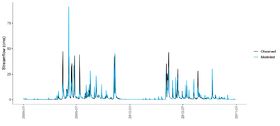Difference between revisions of "Main Page"
| Line 1: | Line 1: | ||
| − | [[File:Kouga_weir_resize.JPG|alt=|left | + | [[File:Kouga_weir_resize.JPG|alt=|left|333x333px]] |
==='''<big>Welcome!</big>'''=== | ==='''<big>Welcome!</big>'''=== | ||
'''This wiki site was built to provide guidance for people working on hydrological modelling projects in South Africa, with a focus on catchment-scale modelling.''' | '''This wiki site was built to provide guidance for people working on hydrological modelling projects in South Africa, with a focus on catchment-scale modelling.''' | ||
| − | [[File:Conceptual_model_diagram_bucket_style.jpg|alt=|left | + | [[File:Conceptual_model_diagram_bucket_style.jpg|alt=|left|250x250px]] |
| Line 10: | Line 10: | ||
This wiki is a living resource: there are discussion pages and the user community can suggest updates. A moderator group will review content changes. | This wiki is a living resource: there are discussion pages and the user community can suggest updates. A moderator group will review content changes. | ||
| − | [[File:Modelled_vs_observed_flow_demo.jpg|alt=|left|frameless|280x280px | + | [[File:Modelled_vs_observed_flow_demo.jpg|alt=|left|frameless|280x280px]] |
The idea for this site came from a group of early-career hydrologists facing many tricky modelling decisions in their research and projects. The Water Research Commission (WRC) funded the initial development of the material through the “Critical catchment model inter-comparison and model use guidance development” project (2019-2021). This project included a review of the structures and use experience across several commonly used modelling tools in South Africa: | The idea for this site came from a group of early-career hydrologists facing many tricky modelling decisions in their research and projects. The Water Research Commission (WRC) funded the initial development of the material through the “Critical catchment model inter-comparison and model use guidance development” project (2019-2021). This project included a review of the structures and use experience across several commonly used modelling tools in South Africa: | ||
| − | *** | + | *** Pitman, including WRSM-Pitman & SPATSIM-Pitman |
*** ACRU | *** ACRU | ||
*** SWAT | *** SWAT | ||
Revision as of 16:48, 23 April 2021
Welcome!
This wiki site was built to provide guidance for people working on hydrological modelling projects in South Africa, with a focus on catchment-scale modelling.
Catchment modelling entails a lot of decision-making, from how many and which land cover types to include in a model, to which modelling software tool to use for a project. The goal of this site is to assist people in making informed decisions in this process and contribute to the ‘wise-use’ of modelling for the benefit of water resources management. You can find more details about the scope of this wiki here.
This wiki is a living resource: there are discussion pages and the user community can suggest updates. A moderator group will review content changes.
The idea for this site came from a group of early-career hydrologists facing many tricky modelling decisions in their research and projects. The Water Research Commission (WRC) funded the initial development of the material through the “Critical catchment model inter-comparison and model use guidance development” project (2019-2021). This project included a review of the structures and use experience across several commonly used modelling tools in South Africa:
- Pitman, including WRSM-Pitman & SPATSIM-Pitman
- ACRU
- SWAT
- MIKE-SHE.
More information and reports from that project are found here.


